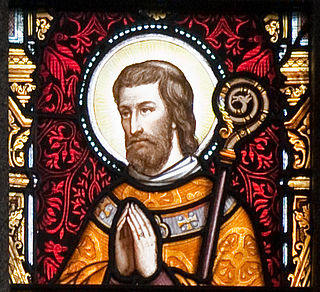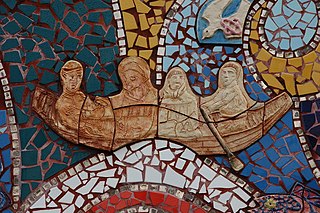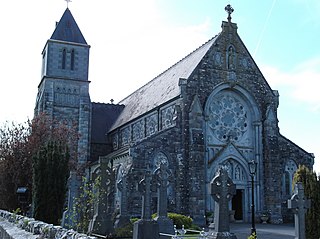
Piran or Pyran, died c. 480, was a 5th-century Cornish abbot and saint, possibly of Irish origin. He is the patron saint of tin-miners, and is also generally regarded as the patron saint of Cornwall, although Michael and Petroc also have some claim to this title.

Saint Máedóc of Ferns, also known as Saint Aidan, Saint Madoc or Saint Mogue, was an Irish saint who was the first Bishop of Ferns in County Wexford and the founder of thirty churches. His birth name was Áed, the name of the Irish god of the underworld, meaning "fire". The name Aidan is a diminutive form of Aed or Aodh, and was also a form of the Latin name Dominus. Máedóc and Mogue are other pet forms of Aed or Aodh, formed from the Irish affectionate prefix mo- and the diminutive suffix -óg, meaning "young", making for something like "my dear little Aodh".
Saint Carthage the Elder was an Irish bishop and abbot in the sixth century. His feast day is 5 March.

Saint Ciarán of Clonmacnoise, supposedly born Ciarán mac an tSaeir, was one of the Twelve Apostles of Ireland and the first abbot of Clonmacnoise. He is sometimes called Ciarán the Younger to distinguish him from the 5th-century Saint Ciarán the Elder who was bishop of Osraige. His name produced many variant spellings, including Ceran, Kieran, Queran and Queranus.

Saint Comgall, an early Irish saint, was the founder and abbot of the great Irish monastery at Bangor in Ireland.
Senán mac Geircinn was an Irish Christian minister. He was a resident of Munster and is important in Irish tradition, as founder of Inis Cathaigh and patron of the Corco Baiscinn and the Uí Fhidgeinte. He is listed among the Twelve Apostles of Ireland.
St. Ultan of Ardbraccan, also known as Ultan the scribe was an Irish saint and Abbot-Bishop of Ardbraccan during the 7th century. He died c. 657 and his feast day is celebrated on 4 September.

March 4 - Eastern Orthodox liturgical calendar - March 6

Saint Ailbe, usually known in English as St Elvis (British/Welsh), Eilfyw or Eilfw, was regarded as the chief 'pre-Patrician' saint of Ireland. He was a bishop and later saint.

Ciarán of Saigir, also known as Ciarán mac Luaigne or Saint Kieran, was one of the Twelve Apostles of Ireland and is considered the first saint to have been born in Ireland, although the legend that he preceded Saint Patrick is questionable. Ciarán was bishop of Saighir (Seir-Kieran) and remains the patron saint of its successor, the diocese of Ossory.

Saint Gobnait, also known as Gobnat or Mo Gobnat or Abigail or Deborah, is the name of an early medieval female Irish saint whose church was Móin Mór, later Bairnech, in the village of Ballyvourney, County Cork in Ireland. She is associated with the Múscraige and her church and convent lay on the borders between the Múscraige Mittine and Eóganacht Locha Léin. Her feast day is February 11.
Saint Diarmaid the Just was a Catholic abbot of Inis Clothrann (Inchcleraun), Lough Ree, County Longford and of Faughalstown, County Westmeath and a famous Irish confessor of the late-sixth century.
There is archaeological evidence of insular monasticism as early as the mid 5th century, influenced by establishments in Gaul such as the monastery of Martin of Tours at Marmoutier, the abbey established by Honoratus at Lérins; the abbey of Mont-Saint-Michel; and that of Germanus at Auxerre. Many Irish monks studied at Candida Casa near Whithorn in what is now Galloway in Scotland.
Saint Molua, , was an Irish saint, who was a Christian abbot in the Early Middle Ages. Saint Molua's feast day is on 4 August. He is venerated in the Catholic Church and Eastern Orthodox Church.
Saint Manchán mac Silláin, Manchianus in Latin sources, is the name of an early Irish saint, patron of Liath Mancháin, now Lemanaghan, in County Offaly. He is not to be confused with the scholar Manchán or Manchéne, abbot of Min Droichit . There are variant traditions concerning the saint's pedigree, possibly owing to confusion with one of several churchmen named Manchán or Mainchín. The most reliable genealogy makes him a son of Sillán son of Conall, who is said be a descendant of Rudraige Mór of Ulster, and names his mother Mella.
Events from the 6th century in Ireland.

Abbán of Corbmaic, also Eibbán or Moabba, was a saint and abbot. He is associated, first and foremost, with the Mag Arnaide. His order was, however, also connected to other churches elsewhere in Ireland, notably that of his alleged sister Gobnait.

Declán of Ardmore, also called Déclán, was an early Irish saint of the Déisi Muman, who was remembered for having converted the Déisi in the late 5th century and for having founded the monastery of Ardmore in what is now County Waterford. The principal source for his life and cult is a Latin Life of the 12th century. Like Ailbe of Emly, Ciarán of Saigir and Abbán of Moyarney, Declán is presented as a Munster saint who preceded Saint Patrick in bringing Christianity to Ireland. He was regarded as a patron saint of the Déisi of East Munster.
Shelmaliers is a Gaelic Athletic Association club based in Castlebridge, County Wexford, Ireland. The club was founded in 1886, with the name Shelmaliers being adopted in 1952, and fields teams in hurling, Gaelic football and camogie.

St. Iberius' Church is an 18th-century Protestant church in the centre of Wexford, Ireland, dedicated to Saint Ibar of Beggerin. Designed by John Roberts, the interior is Georgian in style, while the exterior is Renaissance Revival. It is a protected structure.











